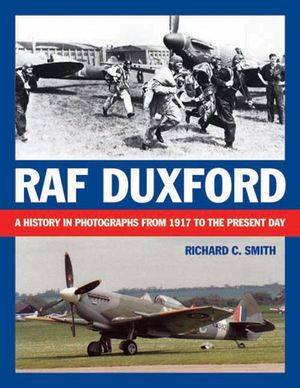RAF Duxford
Published by Grub Street Publishing
A pictorial account of the airfield’s 90-year history—from WWI to housing the largest collection of war and peacetime vintage aircraft in Europe.
Established in 1917 to train Royal Flying Corps aircrew, during WWI Duxford was also the base for two United States Aero Squadrons, 137 and 159, and by the end was a mobilization airfield for three DH9 day bomber squadrons. During the 1920s and 30s, expansion continued apace, with three fighter squadrons, 19, 29 and 111, and the presence of many illustrious names, including Harry Broadhurst, Johnny Kent and Frank Whittle.
The first aerodrome in Fighter Command to receive the Spitfire (in August 1938), Duxford rose to supreme prominence during the early part of the Second World War. Part of 12 Group detailed to protect the industrial midlands and north east Britain, the base’s role during the Battle of Britain was mired in controversy due to the “Big Wing” tactics of Douglas Bader and Trafford Leigh-Mallory. From October 1942 to the end of the war, Duxford was essentially an American base for, variously the 8th Air Force, 357th and 78th Fighter Groups. Postwar the RAF operated jets from the station until 1961 when the future was put on hold. Managing to avoid the ignominy of becoming a prison or sports complex, the Imperial War Museum finally came to the rescue making Duxford into today’s premier international air museum.
Richard Smith’s research has led him to numerous previously unpublished collections form which he has unearthed some marvelous images of historical significance. A must for the collector, historian, or veteran of the times.
Established in 1917 to train Royal Flying Corps aircrew, during WWI Duxford was also the base for two United States Aero Squadrons, 137 and 159, and by the end was a mobilization airfield for three DH9 day bomber squadrons. During the 1920s and 30s, expansion continued apace, with three fighter squadrons, 19, 29 and 111, and the presence of many illustrious names, including Harry Broadhurst, Johnny Kent and Frank Whittle.
The first aerodrome in Fighter Command to receive the Spitfire (in August 1938), Duxford rose to supreme prominence during the early part of the Second World War. Part of 12 Group detailed to protect the industrial midlands and north east Britain, the base’s role during the Battle of Britain was mired in controversy due to the “Big Wing” tactics of Douglas Bader and Trafford Leigh-Mallory. From October 1942 to the end of the war, Duxford was essentially an American base for, variously the 8th Air Force, 357th and 78th Fighter Groups. Postwar the RAF operated jets from the station until 1961 when the future was put on hold. Managing to avoid the ignominy of becoming a prison or sports complex, the Imperial War Museum finally came to the rescue making Duxford into today’s premier international air museum.
Richard Smith’s research has led him to numerous previously unpublished collections form which he has unearthed some marvelous images of historical significance. A must for the collector, historian, or veteran of the times.
BUY NOW FROM
COMMUNITY REVIEWS
